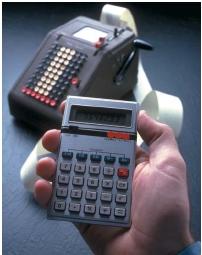Calculator
The calculator is a computing machine. Basic calculators perform basic mathematical functions (addition, subtraction, division, and multiplication). More sophisticated calculators can perform functions of the higher-based mathematical branches of trigonometry and calculus. The odometer, or mileage counter, in an automobile is a counting machine, as is the pocket calculator and the personal computer. They may have different ability levels, but they all tally numbers.
Early calculators
Although the abacus, the first tool of calculation, has existed since ancient times, advanced calculating machines did not appear until the early 1600s. Blaise Pascal, a French scientist and philosopher, developed in 1642 the

Pascaline , a machine capable of adding and subtracting nine-digit numbers. Figures were entered by moving numbered wheels linked to each other by gear, similar to a modern automobile's odometer. In 1671, German philosopher and mathematician Gottfried Wilhelm Leibniz improved Pascal's design, creating a machine that performed multiplication. In 1820, Frenchman Charles X. Thomas devised a machine that added subtraction and division to a Leibniz-type calculator. It was the first mass-produced calculator, and it became a common sight in business offices.
Over the next century, mathematicians and inventors improved upon the designs of previous calculating machines. In 1875, American inventor Frank Stephen Baldwin received the first patent for a calculating machine. Baldwin's machine did all four basic mathematical functions and did not need to be reset after each computation. With the need for more accurate record keeping in the business world, calculating machines that used motors to tally larger and larger numbers and mechanisms to print out results on paper were devised. These mechanical machines remained essentially unchanged until the mid-1960s.
Electronic calculators
The integrated circuit chip—tiny, complex electronic circuits on a single chip of silicon—was invented in 1959 by Texas Instruments and Fairchild (a semiconductor manufacturing company). Although integrated circuits allowed calculators to become much faster and smaller, those early electronic calculators were still just adding machines. In 1970, however, the development of the microprocessor—which incorporated the circuitry of the integrated circuit and the entire central processing unit of a computer onto a single chip—changed the computing industry. The microprocessor made pocket-sized, highly sophisticated calculators possible.
Today, pocket calculators with a wide range of functions are available, including programmable calculators that are in effect miniature computers. Some calculators are powered by solar cells in ordinary room light. More than 50 million portable calculators are sold in the United States each year, many for less than $10.
[ See also Computer, digital ]
Please answer this it will be helpful as I have an examination on this.